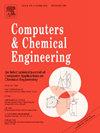基于动态优化的批处理热交换器网络设计
IF 3.9
2区 工程技术
Q2 COMPUTER SCIENCE, INTERDISCIPLINARY APPLICATIONS
引用次数: 0
摘要
目前,批处理过程的能源效率越来越受到人们的关注。热集成是提高能源效率的一种既定方法。然而,与连续过程相比,间歇过程的时间动态行为给热交换器网络设计问题带来了额外的复杂性。此外,在经济优化问题中考虑换热器的投资成本需要对换热器进行空间建模。空间建模通常会导致非线性,从而导致计算困难。在我们的工作中,我们证明了间歇过程的热交换器网络中的时间和空间温度分布都可以通过微分方程有效地建模。介绍了一种用于批量过程换热器网络设计的动态优化模型——Dyn2Heat模型。Dyn2Heat模型考虑了过程持续时间、热交换器的投资成本和公用事业供应的运营成本之间的经济权衡。同时,与非线性代数公式相比,动态公式使模型计算效率高,适用于涉及多个可能换热器的复杂系统。本文章由计算机程序翻译,如有差异,请以英文原文为准。
Dyn2Heat – MILP Heat Exchanger Network Design for Batch Processes via Dynamic Optimization
Nowadays, the energy efficiency of batch processes is getting increasing attention. Heat integration is an established approach to increase energy efficiency. However, compared to continuous processes, the temporally dynamic behaviour of batch processes introduces additional complexity to the heat exchanger network design problem. Furthermore, including investment costs of heat exchangers in the economic optimization problem requires spatial modelling of the heat exchangers. The spatial modelling usually leads to nonlinearities, which can lead to computational intractability. In our work, we demonstrate that both, the temporal and the spatial temperature profiles in a heat exchanger network for batch processes, can be modelled efficiently by differential equations. We introduce the Dyn2Heat model, a dynamic optimization model for heat exchanger network design for batch processes. The Dyn2Heat model considers the economic trade-off between process duration, investment costs for heat exchangers and operational costs for utility supply. At the same time, the dynamic formulation makes the model computationally efficient in comparison to a nonlinear algebraic formulation and applicable to complex systems involving several possible heat exchangers.
求助全文
通过发布文献求助,成功后即可免费获取论文全文。
去求助
来源期刊

Computers & Chemical Engineering
工程技术-工程:化工
CiteScore
8.70
自引率
14.00%
发文量
374
审稿时长
70 days
期刊介绍:
Computers & Chemical Engineering is primarily a journal of record for new developments in the application of computing and systems technology to chemical engineering problems.
 求助内容:
求助内容: 应助结果提醒方式:
应助结果提醒方式:


